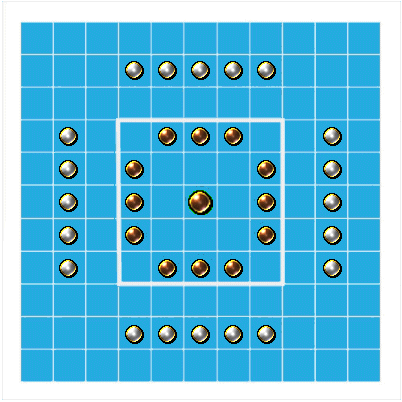

Breakthru is analogous to a naval battle. The gold fleet
consists of one large flagship and twelve escort ships. The
objective is to evade capture while breaking through the blockade
to transport the flagship to the perimeter of the board. The
other player has a silver fleet of twenty ships, and forms a
blockade to trap the gold flagship with the objective of
capturing it.
Players move alternately by making two moves or one
displacement capture. When the flagship is moved, only one move
or capture is made. A player may move two of the smaller
ships any number of vacant squares, either horizontally or
vertically (as a rook in chess, but without capture). The
flagship moves and captures like the other ships. However, if the
flagship is moved, the gold player may not move another
piece.
Capture is performed by displacement, by moving one square
diagonally. If the flagship reaches one of the outermost squares
on the board, gold player wins. If the flagship is captured,
silver player wins. Silver must try and surround Gold, minimizing
his freedom of movement. Thus, Silver should avoid exchanging too
many pieces, as this creates open corridors for the Flagship to
elope. Gold, on the other hand, should strive to exchange
pieces.
Breakthru was designed by Alex Randolph and commercially
released by 3M Company in 1965, as part of the 3M bookshelf game
series. Breakthru has much in common with the Tafl games of the
Middle Ages, such as Hnefatafl or Alea Evangelii, as there are
unevenly matched teams with different objectives (cf. Wikipedia).
The original rules give four different setups, which are all
included as variants. (Water sound by Mike Koenig, Soundbible.com.)
References
‘Breakthru’. Board and Pieces. (here)
‘Breakthru (board_game)’. Wikipedia article.
(here)
☛ You can download my free Breakthru program here, but you must own the software Zillions of Games to be able to run it. (I recommend the download version.)
© M. Winther, 2018 August